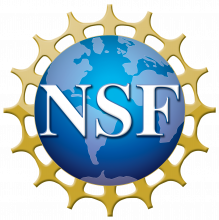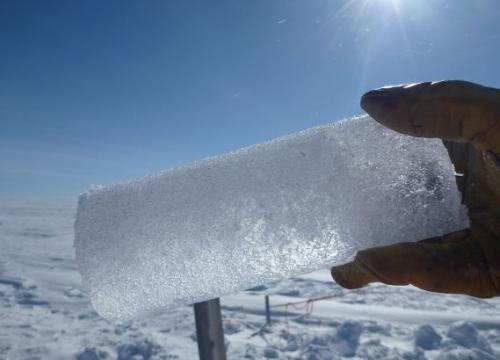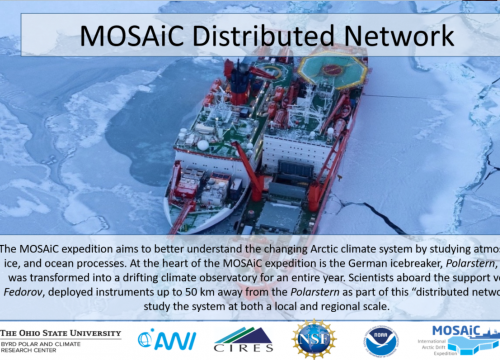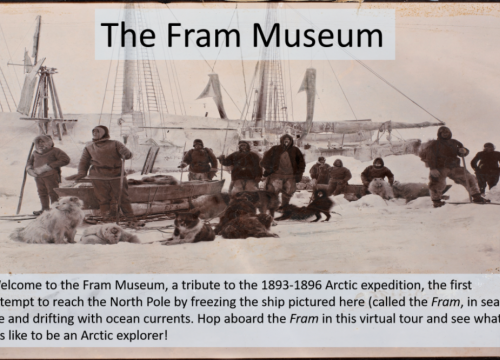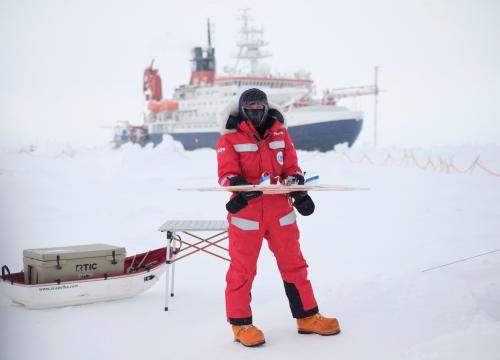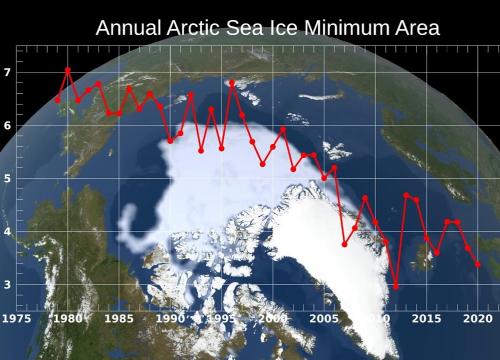In this MS/HS unit, students compare and contrast Arctic expeditions of the past (1893-1896 Fram expedition) and the present (2019-2020 MOSAiC expedition) to prepare for the Arctic of the future.
Context for Use
Exploring the Old and New Arctic is a nature of science unit in which students will compare and contrast past (Fram) and present (MOSAiC) Arctic expeditions, to prepare for the future. The unit is developed around the driving question, “How have scientific questions, methods, technologies, and our knowledge of the Arctic changed over time?”, and consists of 5+ unique lessons, each tied to NGSS Nature of Science understandings. At the end of each lesson, students complete an exit ticket and update a whole class summary table in order to keep track of similarities and differences between the Fram and MOSAiC expeditions. Students will reference their exit tickets and the final summary table when completing the final assessment, a visual representation of the unit driving question.
- Find the Unit Summary here.
- Facilitate the unit in parts or all at once! Find the Instructional Calendar here.

MOSAiC scientists drill through the Arctic sea ice, the research vessel Polarstern illuminated in the background. Photo Credit: Esther Horvath/AWI
Goals Header
Big Ideas
- The process/nature of science is one of adventure, unexpected challenges, and new questions that adds to or refines a body of knowledge
- Changes in one part of Earth’s climate system can cause unexpected changes in another
Teaching Materials
Description
Lesson 1: Introduction to the Arctic
In this lesson, students will define and describe the geography of the Arctic and identify the major players in Arctic politics.
- Driving Question(s):
- Why should we care about the Arctic?
- Learning Goal(s):
- Define and describe the geography of the Arctic
- Identify Arctic stakeholders
- NGSS Nature of Science Understanding:
- Science Addresses Questions About the Natural and Material World: Science knowledge can describe consequences of actions but is not responsible for society’s decisions
Lesson 2: Fram Motivation
In this lesson, students experience the Fram expedition through a virtual reality tour and learn why science truly is a “human endeavor”.
- Driving Question(s):
- What was the motivation for the Fram expedition?
- What human qualities did crew members display during the Fram expedition
- Learning Goal(s):
- Identify and describe human qualities that helped the Fram expedition successfully navigate the Arctic
- NGSS Nature of Science Understanding:
- Science is a Human Endeavor: Scientists and engineers rely on human qualities such as persistence, precision, reasoning, logic, imagination, and creativity
Lesson 3: MOSAiC Motivation
In this lesson students discover what is motivating hundreds of scientists from around the world to spend a year, frozen in ice as a part of the MOSAiC expedition.
- Driving Question(s):
- What is the motivation for the MOSAiC expedition?
- Learning Goal(s):
- Identify factors contributing to changes in sea ice extent (growth and melt)
- Describe and compare sea ice extent observations to model projections
- NGSS Nature of Science Understanding:
- Scientific Knowledge is Open to Revision in Light of New Evidence: Scientific explanations are subject to revision and improvement in light of new evidence
Lesson 4: Ice Floe Identification
In this 2-day lesson, students will analyze and interpret data about Arctic sea ice to find a location with ice floes suitable for attaching an icebreaker to.
- Driving Question(s):
- What do various data tell you about Arctic sea ice conditions, and how can you use this data to identify an ice floe with desired characteristics?
- Learning Goal(s):
- Scientific investigations use a variety of methods, and scientists use existing data and evidence to inform and achieve scientific research goals
- Sea ice in the Arctic is dynamic and not uniform everywhere. It changes seasonally and over longer periods of time due to natural and human-induced forcings.
- We can get information about sea ice using a variety of instruments and methods (optical satellite, radar satellite, ice cores, drifting buoys, etc.)
- NGSS Nature of Science Understanding:
- Scientific Investigations Use a Variety of Methods: Science investigations use a variety of methods and tools to make measurements and observations.
Lesson 5: Measuring Albedo
In this lesson, students measure the reflectance (albedo) of different surfaces and create a rule to describe the relationship between the color of a surface and its albedo.
- Driving Question(s):
- What is the relationship between the color of a surface and its albedo?
- What happens to energy that is not reflected by a surface?
- How could a decline in sea ice affect the Arctic’s albedo and temperature?
- Learning Goal(s):
- Describe the relationship between the color and albedo
- Describe the relationship between albedo and temperature
- NGSS Nature of Science Understanding:
- Scientific Knowledge is based on Empirical Evidence: Science knowledge is based upon logical and conceptual connections between evidence and explanations.
Lesson 6: Final Assessment
In this lesson, students work in pairs to construct a visual to answer the unit driving question, “How have scientific questions, methods, technologies, and our knowledge of the Arctic changed over time?”
- Driving Question(s):
- How have scientific questions, methods, technologies, and our knowledge of the Arctic changed over time?
- Learning Goal(s):
- Compare and contrast scientific questions, methods, technologies, and Arctic knowledge from the Fram and MOSAiC expeditions.
- NGSS Nature of Science Understandings:
- Science is a Human Endeavor: Scientists and engineers rely on human qualities such as persistence, precision, reasoning, logic, imagination and creativity
- Scientific Knowledge is Open to Revision in Light of New Evidence: Scientific explanations are subject to revision and improvement in light of new evidence
- Scientific Investigations Use a Variety of Methods: Science investigations use a variety of methods and tools to make measurements and observations.
- Scientific Knowledge is based on Empirical Evidence: Science knowledge is based upon logical and conceptual connections between evidence and explanations.
Optional Lesson: Arctic Preparation
In this lesson, students compare and contrast Arctic vessels of the past (Fram) and present (Polarstern).
- Driving Question(s):
- How are past and present Arctic ship designs similar? Different?
- Learning Goal(s):
- Identify and describe structures and functions characteristic of Arctic vessels, Fram and Polarstern
- NGSS Nature of Science Understanding:
- Science is a Human Endeavor: Advances in technology influence the progress of science and science has influenced advances in technology
Optional Lesson: Ice-Albedo Feedback
In this lesson, students analyze maps to calculate and compare changes in albedo.
- Driving Question(s):
- What is a feedback loop?
- Why does a decline in Arctic sea ice lead to further melting of sea ice?
- Learning Goal(s):
- Describe the ice-albedo feedback loop.
- NGSS Nature of Science Understanding:
- Scientific Knowledge is based on Empirical Evidence: Science knowledge is based upon logical and conceptual connections between evidence and explanations.
